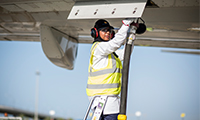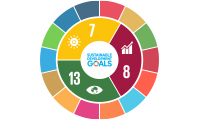Carbon capture and storage
Shell invests in carbon capture and storage (CCS) projects, which use a combination of technologies to capture and store carbon dioxide (CO2) deep underground. We also work with partners to find new ways of using CO2 once it has been captured.
We believe CCS must play a significant role in the global climate response. CCS projects are happening around the world and the technology is proven but more projects need to be built.
The Intergovernmental Panel on Climate Change (IPCC) has said in its latest report in 2018 that the early scaling up of industry CCS is essential to achieving the stringent global warming target of 1.5 degrees Celsius. CCS technology can capture CO2 from existing power infrastructure and heavy, energy-intensive industries like cement and steel.
CCS in Canada
We operate the Quest CCS project (Shell interest 10%) in Canada, which captures and stores CO2 from the Scotford Upgrader. In its first three years of operations, Quest captured and safely stored more than 3 million tonnes of CO2, and achieved this ahead of schedule.
Technology developed by Shell Cansolv is used to capture both sulphur dioxide and CO2 at SaskPower’s Boundary Dam power station in Saskatchewan, Canada. We continue to support SaskPower to improve the application of the technology.
Developing CCS
We are working with our partners to develop new ways to capture CO2 from exhaust gases from industrial facilities. In 2018, we helped launch a pilot project at a biomass power plant in Austria to separate CO2 from flue gases in a lower-cost way. Once captured, the CO2 can be used as, for example, a fertiliser in agriculture. We are working on the project with Wien Energie, the utility that operates the power plant; TU Wien, which developed and ran the pilot project; the University of Natural Resources and Life Sciences; and Bertsch, which built the project.
At the Technology Centre Mongstad (TCM), Shell – together with the Norwegian government, Equinor and Total – is undertaking further research and development into CCS to help reduce the technology's costs. In 2017, we reaffirmed our involvement in continued testing at TCM until 2020. Shell and its TCM partners are also working on a full-scale project that includes the capture of CO2 from industrial facilities in Eastern Norway. The CO2 would then be transported by ship to an onshore receiving plant before being injected into an offshore saline aquifer.
In 2018, the Oil and Gas Climate Initiative investment-arm, Climate Investments, announced that it is entering into a strategic partnership with Shell and other oil and gas companies to analyse the potential development of the UK’s first commercial full-chain carbon capture utilisation and storage (CCUS) project in Teesside. Climate Investments also invested in three innovative companies involved in CCUS, including Solidia Technologies, which has developed systems for producing lower-emissions cement and concrete cured with CO2 rather than water.
We also announced we will provide a monetary contribution to support the work of the International Energy Agency over the next three years to enable the agency to increase its focus on partnerships, and more specifically, work with its partner countries to identify how to accelerate CCUS deployment.
We are involved in the Gorgon CO2 injection project (Shell interest 25%) in Australia, which is due to start up in 2019. It will be the world’s largest CCS operation when completed. The project plans to separate and inject between 3.4 million and 4 million tonnes of reservoir CO2 each year. Over the life of the project, it is expected that around 100 million tonnes of reservoir CO2 will be captured and stored. During the pre-start up and commissioning checks of the injection project, some issues were identified that are being rectified before injection begins.
How carbon capture and storage works
See what is involved in the process of capturing and storing carbon dioxide deep underground
 Our people
Our people
 Sustainable development goals
Sustainable development goals
 About our data
About our data
 Electricity
Electricity